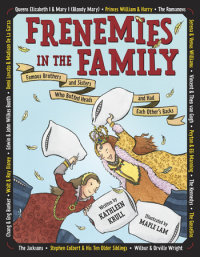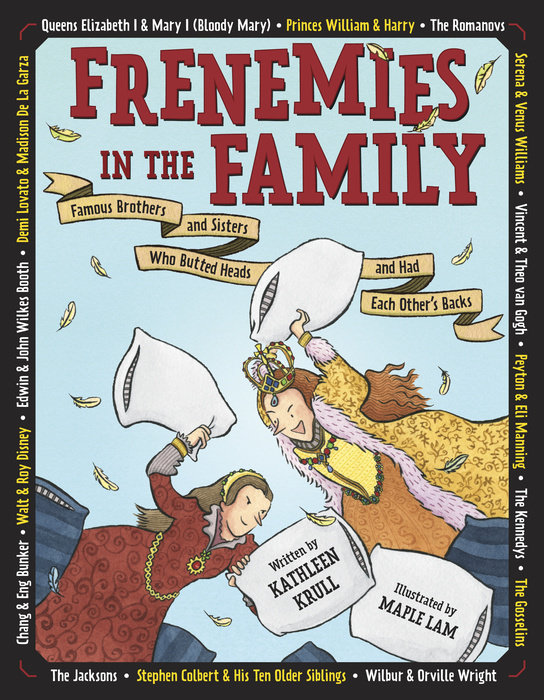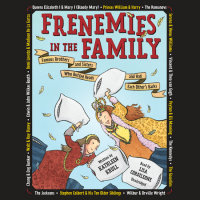Frenemies in the Family
One minute you can't live without them . . . the next minute you don't want them breathing your air! Siblings everywhere will relate to this humorous look at famous brothers and sisters whose important bonds have shaped their accomplishments . . . (mostly) for the better.
They blame you when they get in trouble. They seem like your parents' favorite. They are the only enemy you can't live without. Almost everyone has a juicy story about their siblings--even famous people. Meet those who got along, those who didn't, and everyone in between!
Oh, brother! This could get ugly. . . .
An Excerpt fromFrenemies in the Family
The British king Henry VIII doted on his daughter Mary—at first. “This girl never cries!” he boasted.
In 1520, at four years old, Princess Mary was entertaining foreign visitors with her performances on the harpsichord. By nine, she could read and write Latin. Her mother, Catherine of Aragon, oversaw her education, and Henry approved, calling Mary his “pearl of the world” and “token of hope”—even though, like pretty much every king, what he really wanted was a son.
Poor Mary!
Her dad was without question one of the world’s worst husbands, with six wives in all. Henry VIII left the Catholic faith (and forced all his subjects to join him) so that he could divorce Catherine on shaky grounds (mainly that lack of-a-son thing) and banish her from court. It was a terrible blow to seventeen-year- old Mary, who never saw her mother again.
Even worse, Henry’s next wife, Anne Boleyn, had a daughter, Elizabeth, who instantly became the Favored One. Anne stripped Mary of her princess title and forced her to act as lady-in- waiting to the new princess, her baby half sister.
The indignities piled up. Mary actually had to walk behind the baby—sometimes it took slaps to enforce this. Elizabeth got the place of honor at the table (Mary ate in her rooms). The baby was dressed in gold-embroidered caps, gowns of green satin or orange velvet. No expense was spared for her, while Mary had to give up servants and return some of her jewels. When Mary protested, Henry dispatched his most important duke—who threatened to crack her skull against the wall.
Perhaps Mary never cried as a baby, but now that was all she did, presumably out of her dad’s hearing.
Poor Elizabeth!
Before she reached her third birthday, Henry had Anne beheaded (yes, one of the reasons: Elizabeth wasn’t a son). Elizabeth is known to have mentioned Anne only twice afterward but all her life treasured a ring with two miniature portraits of her and her mom.
Poor sisters!
After Henry’s next marriage, the sisters had a half brother, Edward, the new Favored One. His mother, Jane Seymour, died two weeks after his birth (before Henry thought of a reason to dispose of her). The two girls were pushed aside while Edward was groomed to be the next ruler.
By age six, Elizabeth was noted for her unsmiling face; people said that she looked as serious as a forty-year-old. Her dad’s main interest was her moral development, and his theory of child rearing involved surrounding her with “ancient and sad persons.”
She was rescued by a stepmom, the king’s sixth and final wife. Unusually well educated for her day, Catherine Parr made a point of seeing that the obviously promising Elizabeth got the same rigorous education given to male heirs—languages, history, rhetoric, and philosophy. Usually, education for women was sketchy, as you can tell from her tutor’s compliments: “Her mind has no womanly weakness,” he wrote; “her perseverance is equal to that of a man, and her memory long keeps what it quickly picks up.”
Elizabeth ended up much better educated than Mary, who was understandably bitter and insecure. Her father was too busy with his own marriages to arrange one for Mary. At twenty-five, she had no real role—she was just “Lady Mary, and the most unhappy lady in Christendom.”
Elizabeth was thirteen when Henry died. She grieved briefly but immediately regained her famous composure. Mostly he had scared her.
Since women had no power of their own, even nine-year-old Edward was seen as the better choice to rule than his older sisters. When he became king, the men around him began jockeying to be the power behind the throne. Mary and Elizabeth were pawns, tense rivals at a time when everyone around them was plotting for their own gain. People watched closely to see which sister was in favor, and the sisters simply avoided each other during his reign.
When Edward caught an infection and died at age fifteen, in 1553, Mary saw her chance and proclaimed herself England’s first ruling queen. Elizabeth immediately wrote to congratulate her. Then Mary rode triumphantly into London, with Elizabeth riding right behind her, careful not to attract too much attention but also wanting their people to see her at her best.
The show of sisterly love was just that—a show. Mary began making her mistrust very clear. Enemies were conspiring against her, and Elizabeth had no real way to prove she wasn’t one of them.
Perfecting the art of the “answerless answer,” Elizabeth lived in constant dread, her expression usually one of alarm.
No one knew quite what to do with her: Keep her close? Send her away? Anything she did could give Mary a reason to execute her, and Mary really wanted to, but . . . Elizabeth had many supporters. Plus, she was her sister. So Mary played mind games. When Elizabeth would ask to see her, Mary would make her wait days in suspense before answering. Some days they sat together at meals and Mary gave her fur coats or jewels; other days Elizabeth was kept isolated. It was obvious that Mary wanted to keep tabs on her, but really, she couldn’t stand to be around her younger sister.


